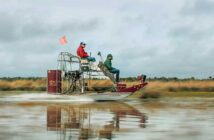From USFW
New genetic research led by two University of Colorado Boulder scientists has produced several fascinating discoveries about Colorado’s native cutthroat trout – including the location of the last surviving wild population of the federally protected greenback cutthroat trout.
The research project, led by Drs. Jessica Metcalf and Andrew Martin, analyzed DNA extracted from wild trout and from museum specimens collected from sites around Colorado and New Mexico as far back as 1857. Researchers used the genetic data from the museum samples as a baseline for understanding the current distribution of Colorado’s cutthroat trout. The study was published Sept. 24 in the journal Molecular Ecology.
Based on their analysis, Metcalf and her coauthors conclude that the only population of true greenback cutthroat trout survives today in Bear Creek, a small tributary of the Arkansas River west of Colorado Springs. Further research suggested that the greenbacks, the native cutthroat of the South Platte, were likely stocked in Bear Creek in the early 1880s.
“We’ve known for some time that the trout in Bear Creek were unique,” said Doug Krieger, senior aquatic biologist for Colorado Parks and Wildlife and the Greenback Cutthroat Trout Recovery Team leader. “But we didn’t realize they were the only surviving greenback population.”
The new study built on 2007 research also led by Metcalf and Martin, which found that several Front Range cutthroat populations thought to be greenbacks were actually West Slope fish that were transplanted to the East Slope.
One of the surprising findings of the new research was the magnitude of those early fish stocking efforts. Poring over historic records, US Fish and Wildlife Service’s fisheries biologist Chris Kennedy, a study co-author, documented that between 1889 and 1925, more than 50 million cutthroat trout from the Gunnison and White River Basins were stocked across Colorado, including locations on the Front Range.
The research findings will trigger a revaluation of the greenback recovery program by the Fish and Wildlife Service and the Recovery Team, which have been overseeing the recovery of the fish since it was placed on the endangered species list in 1973.
Work on the Greenback Trout Recovery Plan was proceeding along a track that suggested recovery plan benchmarks might soon be met. However, the findings will require the Fish and Wildlife Service to reevaluate the taxonomy and status of the species to determine whether adjustments to its status and current protections are warranted. During this process, federal agencies will take a conservative approach when considering management decisions that affect Colorado cutthroat trout and their habitat.
“We think it’s important to note that recovery efforts have preserved the genetic diversity of native cutthroats and their habitat throughout Colorado,” said Mike Thabault, Fish and Wildlife Service Assistant Regional Director for Ecological Services.
With origins from the Pacific Ocean, cutthroat trout are considered to be one of the most diverse fish species in North America and a symbol of wildness in the American West. For thousands of years, cutthroat trout evolved across the western U.S. into 14 recognized subspecies, including the giant yellowfin cutthroat, an Arkansas Basin strain that once grew to prodigious size in Twin Lakes near Leadville.
Scientists had previously identified four closely related lineages of native Colorado trout: the greenback cutthroat east of the Continental Divide, the Colorado River cutthroat from the western slope, the Rio Grande cutthroat in streams surrounding the San Luis Valley and the extinct yellowfin.
Not only has the new research revealed the Bear Creek cutthroat to be the greenback, Metcalf and her colleagues also identified a previously undiscovered San Juan Basin cutthroat that is now extinct. Metcalf also looked for evidence that the yellowfin had survived to modern times, but concluded that it too was extinct.
Colorado Parks and Wildlife aquatic research scientist Kevin Rogers said that the study significantly improves scientists’ understanding of cutthroat biology and serves as a good reminder of how science works.
“The integrity of the scientific process depends on researchers who are willing to use new tools to explore difficult issues and challenge existing paradigms,” Rogers said. “Advances in technology have allowed us to analyze the DNA of fish collected during the early years of Colorado’s settlement. This study has opened an astonishing window into the past.”
To complement the new research by Metcalf and her co-investigators, the Recovery Team is now working with Colorado State University to reexamine the physical characteristics of Colorado cutthroats. When completed, scientists will then compare results from physical examination with the genetic analysis in hopes of further clarifying the evolutionary relationships among native cutthroat trout. Meanwhile, the Fish and Wildlife Service is working with Colorado Parks and Wildlife, the U.S. Forest Service, the National Park Service, the Bureau of Reclamation and academia to develop a decision process to evaluate the current distribution of the various cutthroat strains and to chart a course forward.
A protected broodstock of Bear Creek cutthroats is being propagated in Colorado Parks and Wildlife’s hatchery system and at the Leadville National Fish Hatchery, run by the Fish and Wildlife Service. The offspring will be used to establish wild populations in the future.
Funding for the study was provided by agencies of the Greenback Cutthroat Trout Recovery Team, including the Fish and Wildlife Service, the U.S. Forest Service, the Bureau of Land Management, the National Park Service and Colorado Trout Unlimited.
LINKS & RESOURCES
For more details on the research project including a copy of the study, please visit the University of Colorado News page at: http://colorado.edu/news
For more information on the Greenback Cutthroat Trout Recovery Team, please see: http://www.fws.gov/coloradoes/greenback.html
To learn more about cutthroat conservation and research, please see:
http://wildlife.state.co.us/Research/Aquatic/CutthroatTrout/Pages/CutthroatTrout.aspx




4 Comments
Great piece, Tim. Really appreciate you sharing this, including the links. Well done!
Pingback: ODU Fishing News - Study reveals secrets of Colorado’s cutthroats
Pingback: ODU Fishing News – Study reveals secrets of Colorado's cutthroats | Welcome to the Fishing Gallery
Pingback: Study reveals secrets of Colorado’s cutthroats « OutDoors Unlimited Magazine